Marketing Strategy and Innovation for Degani Cafe: A Detailed Report
VerifiedAdded on 2020/03/16
|10
|2713
|45
Report
AI Summary
This report provides a comprehensive analysis of Degani Cafe's marketing strategy and innovation. It begins with an introduction to the company and its position in the food and beverage industry, followed by an examination of its generic and resource-based view strategies. The report then delves into a PESTLE analysis to assess the external factors impacting Degani Cafe and a Porter's Five Forces analysis to evaluate its competitive environment. A key section explores the fit between the organization's strategy and its context, highlighting the company's core values and strategic approaches. Finally, the report offers specific recommendations for the organization to enhance its marketing efforts, improve customer relations, and achieve sustainable growth. The analysis covers various marketing aspects including promotional strategies, generic strategies, and business-level strategies to overcome competition. The report emphasizes the importance of understanding consumer preferences, technological advancements, and legal regulations in the industry. It also underlines the need for effective human resource management, communication, and diversity within the organization to meet its goals and objectives. The report concludes with a summary of the findings and references relevant academic literature.
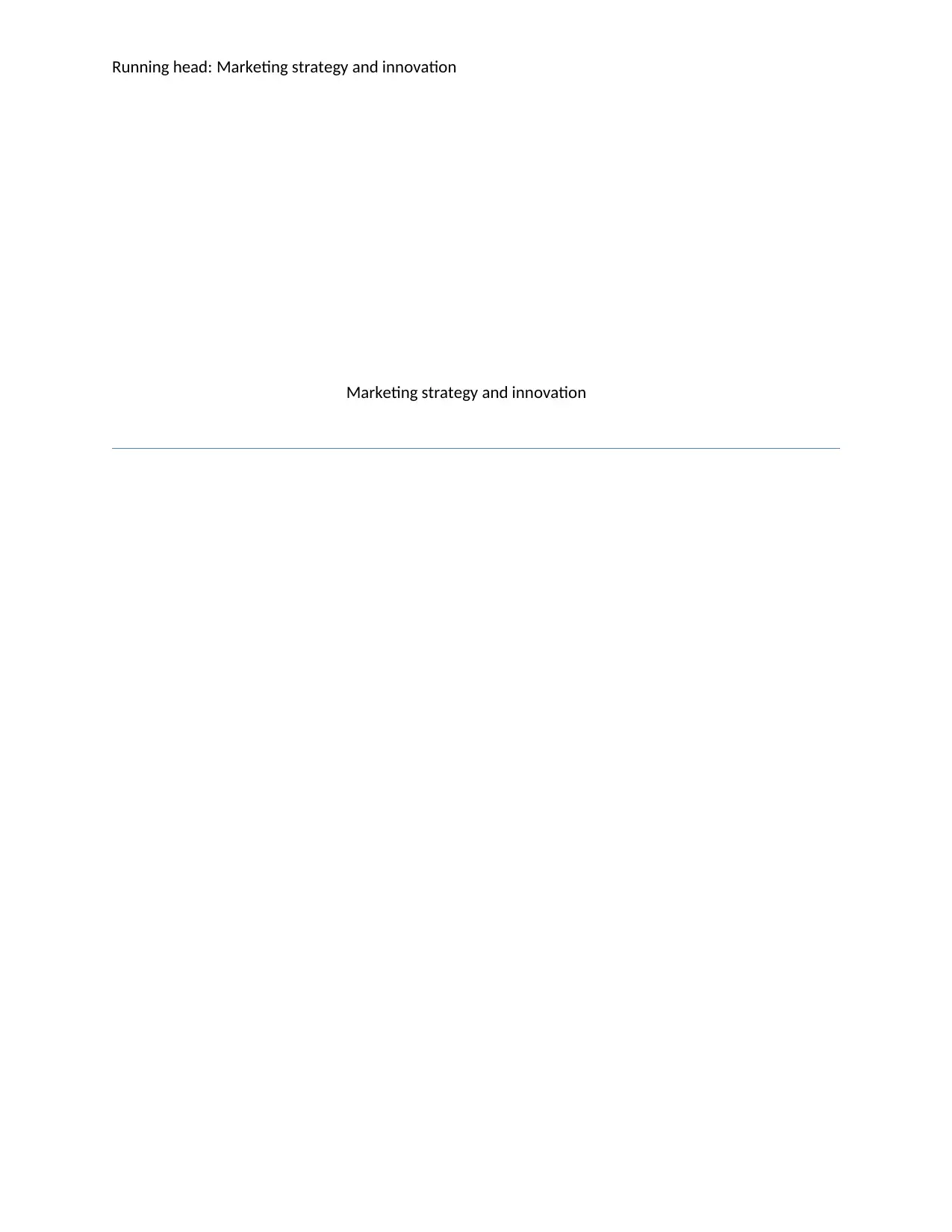
Running head: Marketing strategy and innovation
Marketing strategy and innovation
Marketing strategy and innovation
Paraphrase This Document
Need a fresh take? Get an instant paraphrase of this document with our AI Paraphraser
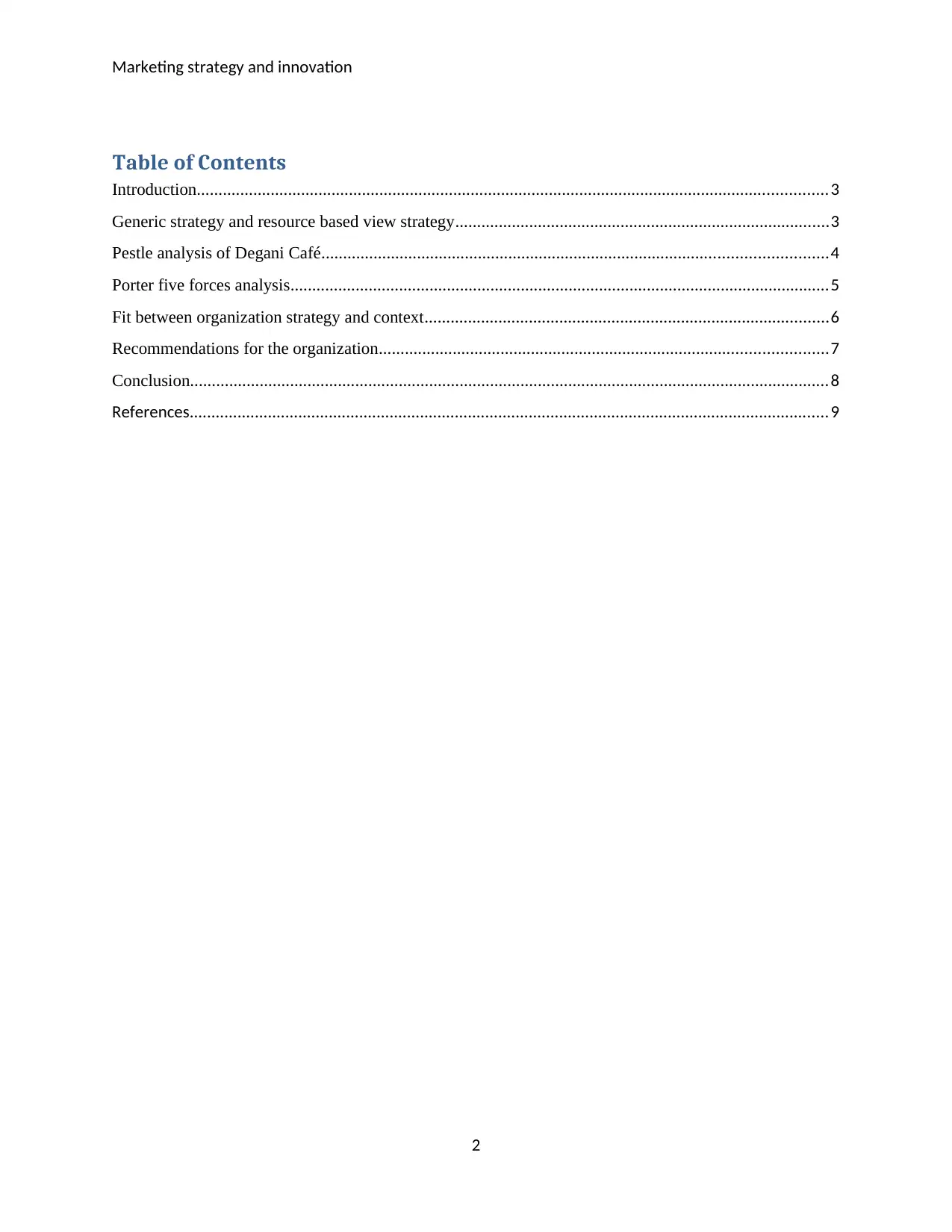
Marketing strategy and innovation
Table of Contents
Introduction.................................................................................................................................................3
Generic strategy and resource based view strategy......................................................................................3
Pestle analysis of Degani Café....................................................................................................................4
Porter five forces analysis............................................................................................................................5
Fit between organization strategy and context.............................................................................................6
Recommendations for the organization.......................................................................................................7
Conclusion...................................................................................................................................................8
References...................................................................................................................................................9
2
Table of Contents
Introduction.................................................................................................................................................3
Generic strategy and resource based view strategy......................................................................................3
Pestle analysis of Degani Café....................................................................................................................4
Porter five forces analysis............................................................................................................................5
Fit between organization strategy and context.............................................................................................6
Recommendations for the organization.......................................................................................................7
Conclusion...................................................................................................................................................8
References...................................................................................................................................................9
2
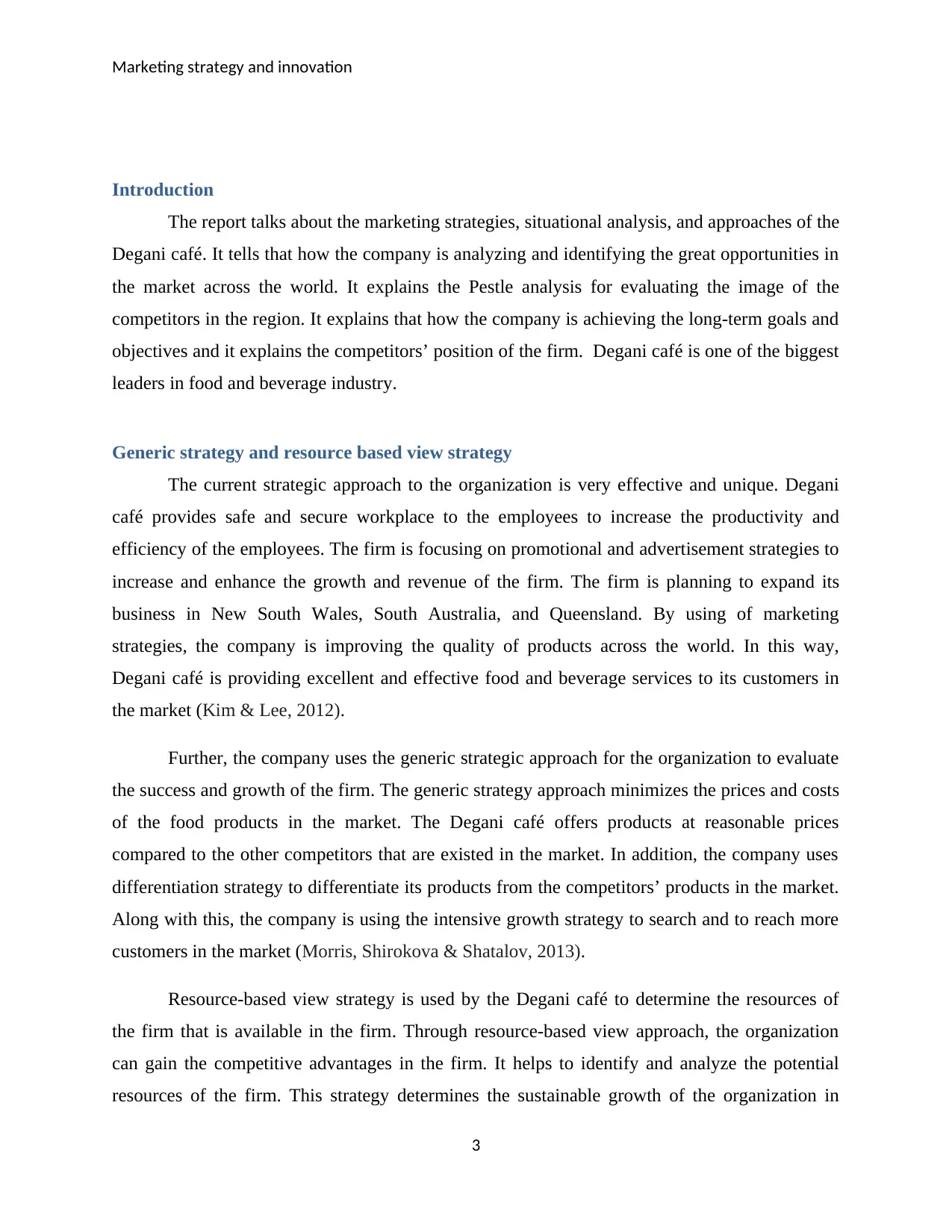
Marketing strategy and innovation
Introduction
The report talks about the marketing strategies, situational analysis, and approaches of the
Degani café. It tells that how the company is analyzing and identifying the great opportunities in
the market across the world. It explains the Pestle analysis for evaluating the image of the
competitors in the region. It explains that how the company is achieving the long-term goals and
objectives and it explains the competitors’ position of the firm. Degani café is one of the biggest
leaders in food and beverage industry.
Generic strategy and resource based view strategy
The current strategic approach to the organization is very effective and unique. Degani
café provides safe and secure workplace to the employees to increase the productivity and
efficiency of the employees. The firm is focusing on promotional and advertisement strategies to
increase and enhance the growth and revenue of the firm. The firm is planning to expand its
business in New South Wales, South Australia, and Queensland. By using of marketing
strategies, the company is improving the quality of products across the world. In this way,
Degani café is providing excellent and effective food and beverage services to its customers in
the market (Kim & Lee, 2012).
Further, the company uses the generic strategic approach for the organization to evaluate
the success and growth of the firm. The generic strategy approach minimizes the prices and costs
of the food products in the market. The Degani café offers products at reasonable prices
compared to the other competitors that are existed in the market. In addition, the company uses
differentiation strategy to differentiate its products from the competitors’ products in the market.
Along with this, the company is using the intensive growth strategy to search and to reach more
customers in the market (Morris, Shirokova & Shatalov, 2013).
Resource-based view strategy is used by the Degani café to determine the resources of
the firm that is available in the firm. Through resource-based view approach, the organization
can gain the competitive advantages in the firm. It helps to identify and analyze the potential
resources of the firm. This strategy determines the sustainable growth of the organization in
3
Introduction
The report talks about the marketing strategies, situational analysis, and approaches of the
Degani café. It tells that how the company is analyzing and identifying the great opportunities in
the market across the world. It explains the Pestle analysis for evaluating the image of the
competitors in the region. It explains that how the company is achieving the long-term goals and
objectives and it explains the competitors’ position of the firm. Degani café is one of the biggest
leaders in food and beverage industry.
Generic strategy and resource based view strategy
The current strategic approach to the organization is very effective and unique. Degani
café provides safe and secure workplace to the employees to increase the productivity and
efficiency of the employees. The firm is focusing on promotional and advertisement strategies to
increase and enhance the growth and revenue of the firm. The firm is planning to expand its
business in New South Wales, South Australia, and Queensland. By using of marketing
strategies, the company is improving the quality of products across the world. In this way,
Degani café is providing excellent and effective food and beverage services to its customers in
the market (Kim & Lee, 2012).
Further, the company uses the generic strategic approach for the organization to evaluate
the success and growth of the firm. The generic strategy approach minimizes the prices and costs
of the food products in the market. The Degani café offers products at reasonable prices
compared to the other competitors that are existed in the market. In addition, the company uses
differentiation strategy to differentiate its products from the competitors’ products in the market.
Along with this, the company is using the intensive growth strategy to search and to reach more
customers in the market (Morris, Shirokova & Shatalov, 2013).
Resource-based view strategy is used by the Degani café to determine the resources of
the firm that is available in the firm. Through resource-based view approach, the organization
can gain the competitive advantages in the firm. It helps to identify and analyze the potential
resources of the firm. This strategy determines the sustainable growth of the organization in
3
⊘ This is a preview!⊘
Do you want full access?
Subscribe today to unlock all pages.

Trusted by 1+ million students worldwide
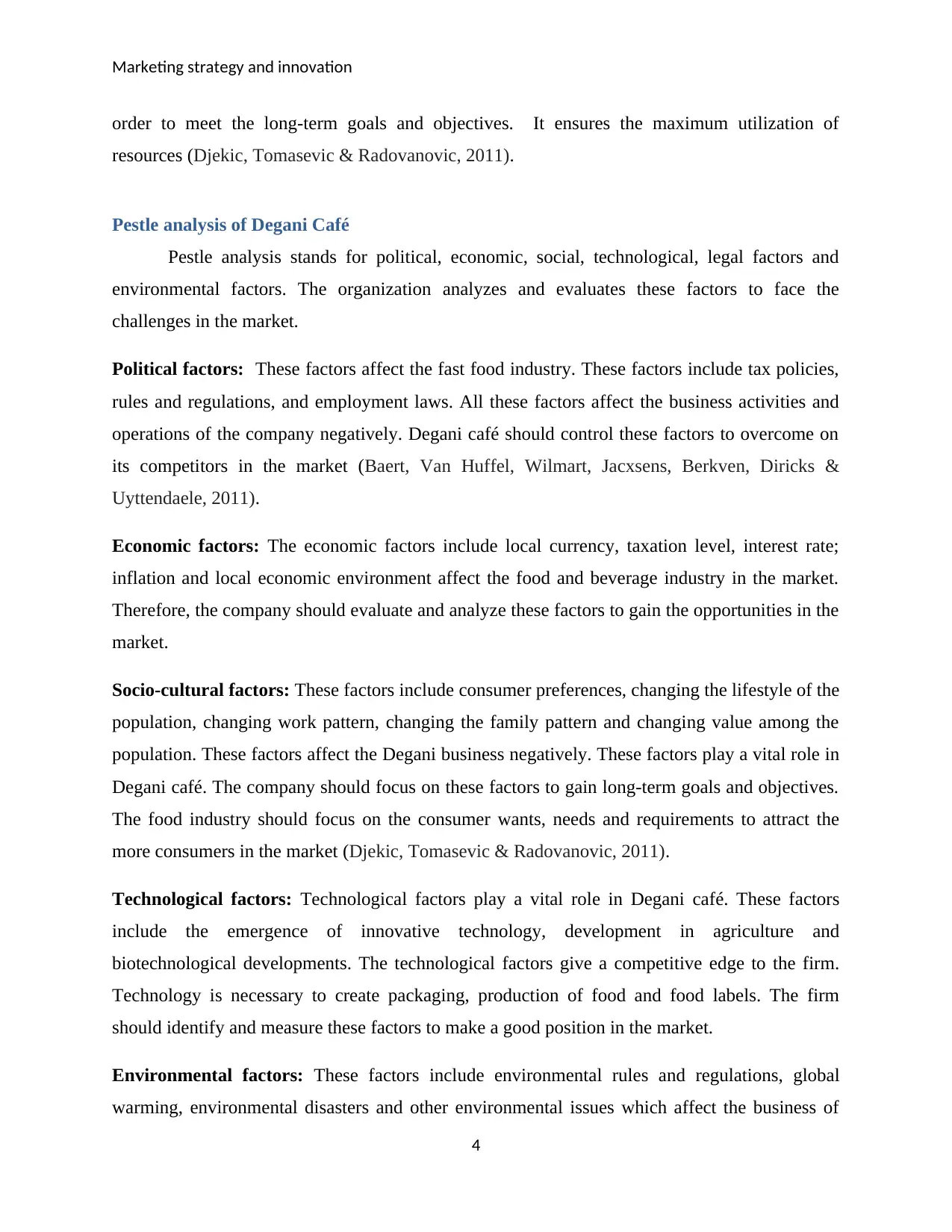
Marketing strategy and innovation
order to meet the long-term goals and objectives. It ensures the maximum utilization of
resources (Djekic, Tomasevic & Radovanovic, 2011).
Pestle analysis of Degani Café
Pestle analysis stands for political, economic, social, technological, legal factors and
environmental factors. The organization analyzes and evaluates these factors to face the
challenges in the market.
Political factors: These factors affect the fast food industry. These factors include tax policies,
rules and regulations, and employment laws. All these factors affect the business activities and
operations of the company negatively. Degani café should control these factors to overcome on
its competitors in the market (Baert, Van Huffel, Wilmart, Jacxsens, Berkven, Diricks &
Uyttendaele, 2011).
Economic factors: The economic factors include local currency, taxation level, interest rate;
inflation and local economic environment affect the food and beverage industry in the market.
Therefore, the company should evaluate and analyze these factors to gain the opportunities in the
market.
Socio-cultural factors: These factors include consumer preferences, changing the lifestyle of the
population, changing work pattern, changing the family pattern and changing value among the
population. These factors affect the Degani business negatively. These factors play a vital role in
Degani café. The company should focus on these factors to gain long-term goals and objectives.
The food industry should focus on the consumer wants, needs and requirements to attract the
more consumers in the market (Djekic, Tomasevic & Radovanovic, 2011).
Technological factors: Technological factors play a vital role in Degani café. These factors
include the emergence of innovative technology, development in agriculture and
biotechnological developments. The technological factors give a competitive edge to the firm.
Technology is necessary to create packaging, production of food and food labels. The firm
should identify and measure these factors to make a good position in the market.
Environmental factors: These factors include environmental rules and regulations, global
warming, environmental disasters and other environmental issues which affect the business of
4
order to meet the long-term goals and objectives. It ensures the maximum utilization of
resources (Djekic, Tomasevic & Radovanovic, 2011).
Pestle analysis of Degani Café
Pestle analysis stands for political, economic, social, technological, legal factors and
environmental factors. The organization analyzes and evaluates these factors to face the
challenges in the market.
Political factors: These factors affect the fast food industry. These factors include tax policies,
rules and regulations, and employment laws. All these factors affect the business activities and
operations of the company negatively. Degani café should control these factors to overcome on
its competitors in the market (Baert, Van Huffel, Wilmart, Jacxsens, Berkven, Diricks &
Uyttendaele, 2011).
Economic factors: The economic factors include local currency, taxation level, interest rate;
inflation and local economic environment affect the food and beverage industry in the market.
Therefore, the company should evaluate and analyze these factors to gain the opportunities in the
market.
Socio-cultural factors: These factors include consumer preferences, changing the lifestyle of the
population, changing work pattern, changing the family pattern and changing value among the
population. These factors affect the Degani business negatively. These factors play a vital role in
Degani café. The company should focus on these factors to gain long-term goals and objectives.
The food industry should focus on the consumer wants, needs and requirements to attract the
more consumers in the market (Djekic, Tomasevic & Radovanovic, 2011).
Technological factors: Technological factors play a vital role in Degani café. These factors
include the emergence of innovative technology, development in agriculture and
biotechnological developments. The technological factors give a competitive edge to the firm.
Technology is necessary to create packaging, production of food and food labels. The firm
should identify and measure these factors to make a good position in the market.
Environmental factors: These factors include environmental rules and regulations, global
warming, environmental disasters and other environmental issues which affect the business of
4
Paraphrase This Document
Need a fresh take? Get an instant paraphrase of this document with our AI Paraphraser
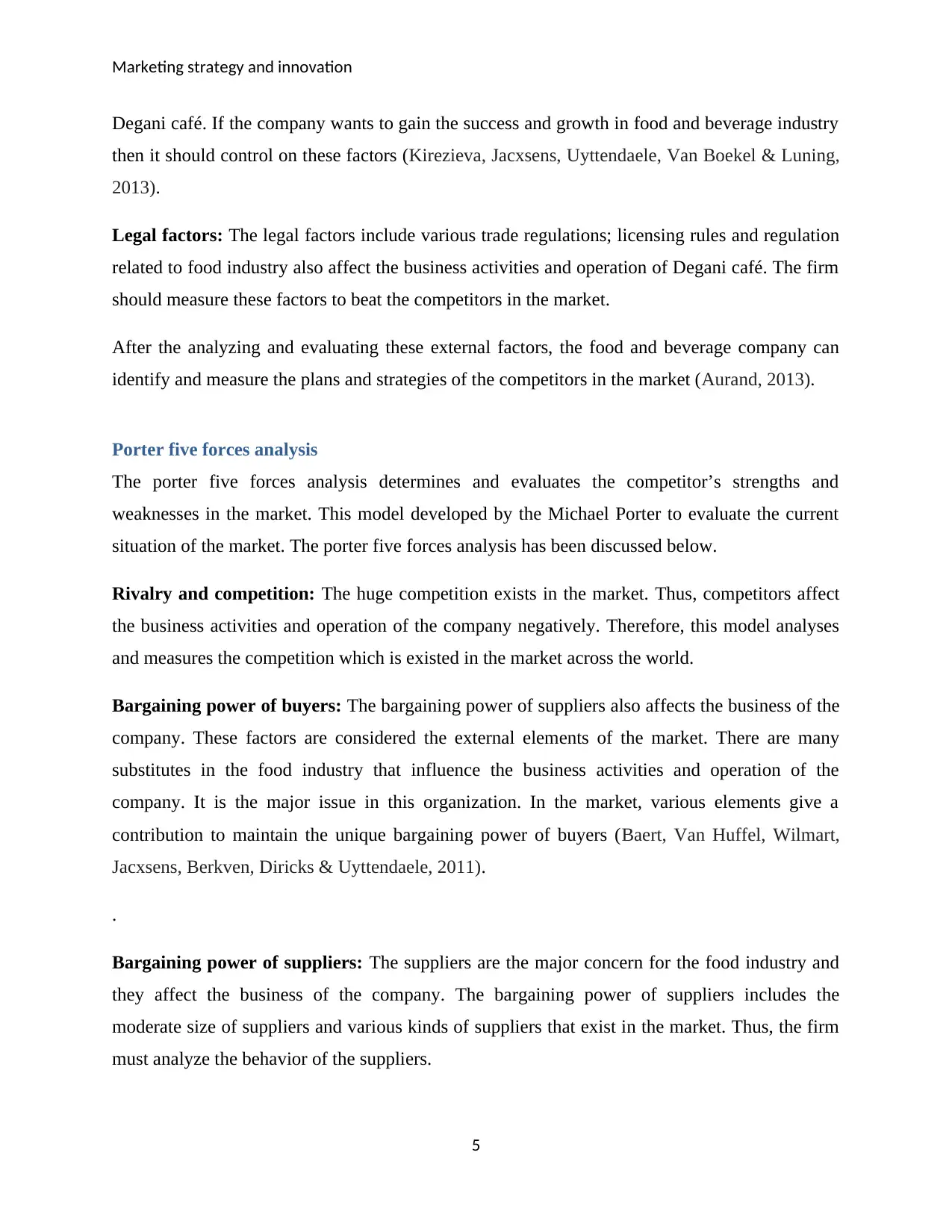
Marketing strategy and innovation
Degani café. If the company wants to gain the success and growth in food and beverage industry
then it should control on these factors (Kirezieva, Jacxsens, Uyttendaele, Van Boekel & Luning,
2013).
Legal factors: The legal factors include various trade regulations; licensing rules and regulation
related to food industry also affect the business activities and operation of Degani café. The firm
should measure these factors to beat the competitors in the market.
After the analyzing and evaluating these external factors, the food and beverage company can
identify and measure the plans and strategies of the competitors in the market (Aurand, 2013).
Porter five forces analysis
The porter five forces analysis determines and evaluates the competitor’s strengths and
weaknesses in the market. This model developed by the Michael Porter to evaluate the current
situation of the market. The porter five forces analysis has been discussed below.
Rivalry and competition: The huge competition exists in the market. Thus, competitors affect
the business activities and operation of the company negatively. Therefore, this model analyses
and measures the competition which is existed in the market across the world.
Bargaining power of buyers: The bargaining power of suppliers also affects the business of the
company. These factors are considered the external elements of the market. There are many
substitutes in the food industry that influence the business activities and operation of the
company. It is the major issue in this organization. In the market, various elements give a
contribution to maintain the unique bargaining power of buyers (Baert, Van Huffel, Wilmart,
Jacxsens, Berkven, Diricks & Uyttendaele, 2011).
.
Bargaining power of suppliers: The suppliers are the major concern for the food industry and
they affect the business of the company. The bargaining power of suppliers includes the
moderate size of suppliers and various kinds of suppliers that exist in the market. Thus, the firm
must analyze the behavior of the suppliers.
5
Degani café. If the company wants to gain the success and growth in food and beverage industry
then it should control on these factors (Kirezieva, Jacxsens, Uyttendaele, Van Boekel & Luning,
2013).
Legal factors: The legal factors include various trade regulations; licensing rules and regulation
related to food industry also affect the business activities and operation of Degani café. The firm
should measure these factors to beat the competitors in the market.
After the analyzing and evaluating these external factors, the food and beverage company can
identify and measure the plans and strategies of the competitors in the market (Aurand, 2013).
Porter five forces analysis
The porter five forces analysis determines and evaluates the competitor’s strengths and
weaknesses in the market. This model developed by the Michael Porter to evaluate the current
situation of the market. The porter five forces analysis has been discussed below.
Rivalry and competition: The huge competition exists in the market. Thus, competitors affect
the business activities and operation of the company negatively. Therefore, this model analyses
and measures the competition which is existed in the market across the world.
Bargaining power of buyers: The bargaining power of suppliers also affects the business of the
company. These factors are considered the external elements of the market. There are many
substitutes in the food industry that influence the business activities and operation of the
company. It is the major issue in this organization. In the market, various elements give a
contribution to maintain the unique bargaining power of buyers (Baert, Van Huffel, Wilmart,
Jacxsens, Berkven, Diricks & Uyttendaele, 2011).
.
Bargaining power of suppliers: The suppliers are the major concern for the food industry and
they affect the business of the company. The bargaining power of suppliers includes the
moderate size of suppliers and various kinds of suppliers that exist in the market. Thus, the firm
must analyze the behavior of the suppliers.
5
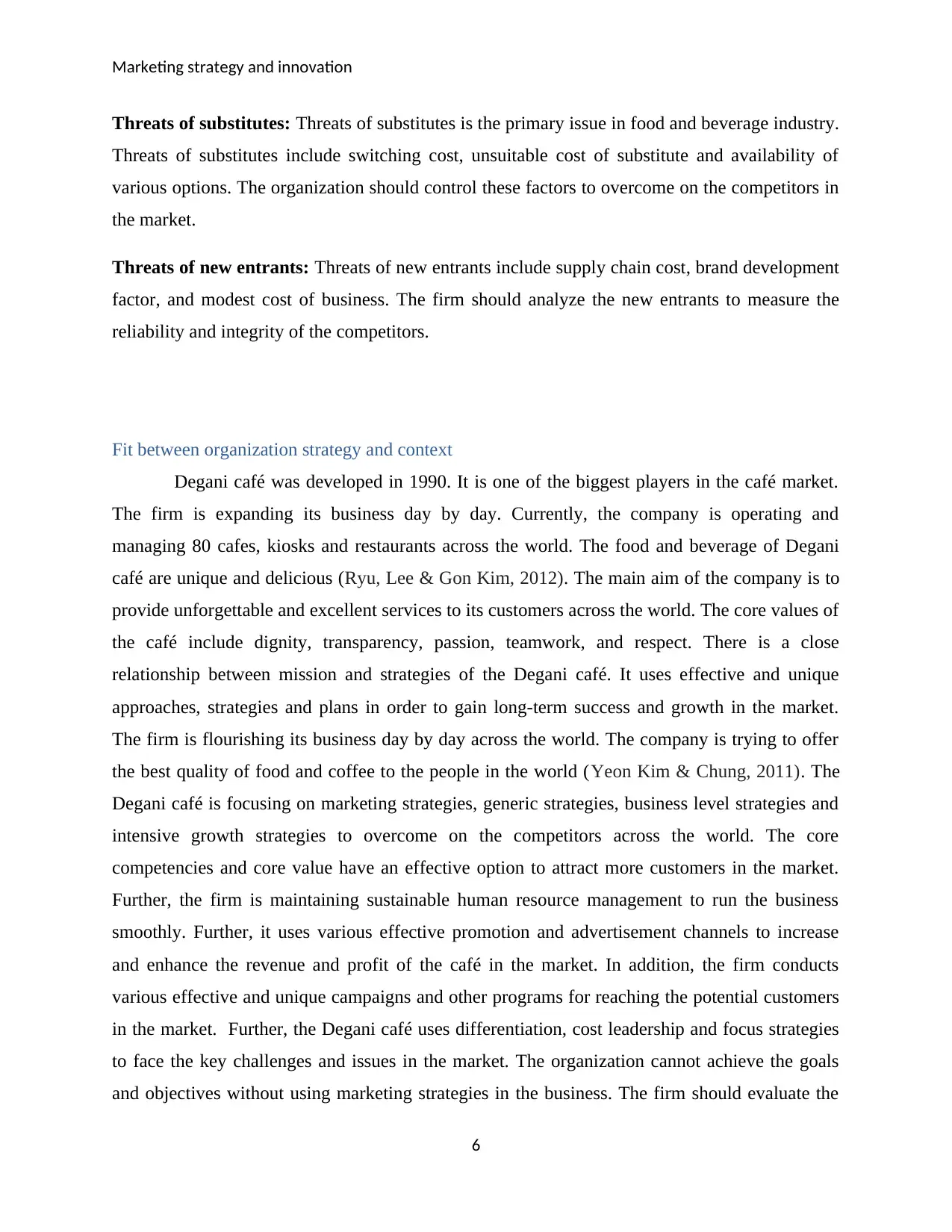
Marketing strategy and innovation
Threats of substitutes: Threats of substitutes is the primary issue in food and beverage industry.
Threats of substitutes include switching cost, unsuitable cost of substitute and availability of
various options. The organization should control these factors to overcome on the competitors in
the market.
Threats of new entrants: Threats of new entrants include supply chain cost, brand development
factor, and modest cost of business. The firm should analyze the new entrants to measure the
reliability and integrity of the competitors.
Fit between organization strategy and context
Degani café was developed in 1990. It is one of the biggest players in the café market.
The firm is expanding its business day by day. Currently, the company is operating and
managing 80 cafes, kiosks and restaurants across the world. The food and beverage of Degani
café are unique and delicious (Ryu, Lee & Gon Kim, 2012). The main aim of the company is to
provide unforgettable and excellent services to its customers across the world. The core values of
the café include dignity, transparency, passion, teamwork, and respect. There is a close
relationship between mission and strategies of the Degani café. It uses effective and unique
approaches, strategies and plans in order to gain long-term success and growth in the market.
The firm is flourishing its business day by day across the world. The company is trying to offer
the best quality of food and coffee to the people in the world (Yeon Kim & Chung, 2011). The
Degani café is focusing on marketing strategies, generic strategies, business level strategies and
intensive growth strategies to overcome on the competitors across the world. The core
competencies and core value have an effective option to attract more customers in the market.
Further, the firm is maintaining sustainable human resource management to run the business
smoothly. Further, it uses various effective promotion and advertisement channels to increase
and enhance the revenue and profit of the café in the market. In addition, the firm conducts
various effective and unique campaigns and other programs for reaching the potential customers
in the market. Further, the Degani café uses differentiation, cost leadership and focus strategies
to face the key challenges and issues in the market. The organization cannot achieve the goals
and objectives without using marketing strategies in the business. The firm should evaluate the
6
Threats of substitutes: Threats of substitutes is the primary issue in food and beverage industry.
Threats of substitutes include switching cost, unsuitable cost of substitute and availability of
various options. The organization should control these factors to overcome on the competitors in
the market.
Threats of new entrants: Threats of new entrants include supply chain cost, brand development
factor, and modest cost of business. The firm should analyze the new entrants to measure the
reliability and integrity of the competitors.
Fit between organization strategy and context
Degani café was developed in 1990. It is one of the biggest players in the café market.
The firm is expanding its business day by day. Currently, the company is operating and
managing 80 cafes, kiosks and restaurants across the world. The food and beverage of Degani
café are unique and delicious (Ryu, Lee & Gon Kim, 2012). The main aim of the company is to
provide unforgettable and excellent services to its customers across the world. The core values of
the café include dignity, transparency, passion, teamwork, and respect. There is a close
relationship between mission and strategies of the Degani café. It uses effective and unique
approaches, strategies and plans in order to gain long-term success and growth in the market.
The firm is flourishing its business day by day across the world. The company is trying to offer
the best quality of food and coffee to the people in the world (Yeon Kim & Chung, 2011). The
Degani café is focusing on marketing strategies, generic strategies, business level strategies and
intensive growth strategies to overcome on the competitors across the world. The core
competencies and core value have an effective option to attract more customers in the market.
Further, the firm is maintaining sustainable human resource management to run the business
smoothly. Further, it uses various effective promotion and advertisement channels to increase
and enhance the revenue and profit of the café in the market. In addition, the firm conducts
various effective and unique campaigns and other programs for reaching the potential customers
in the market. Further, the Degani café uses differentiation, cost leadership and focus strategies
to face the key challenges and issues in the market. The organization cannot achieve the goals
and objectives without using marketing strategies in the business. The firm should evaluate the
6
⊘ This is a preview!⊘
Do you want full access?
Subscribe today to unlock all pages.

Trusted by 1+ million students worldwide
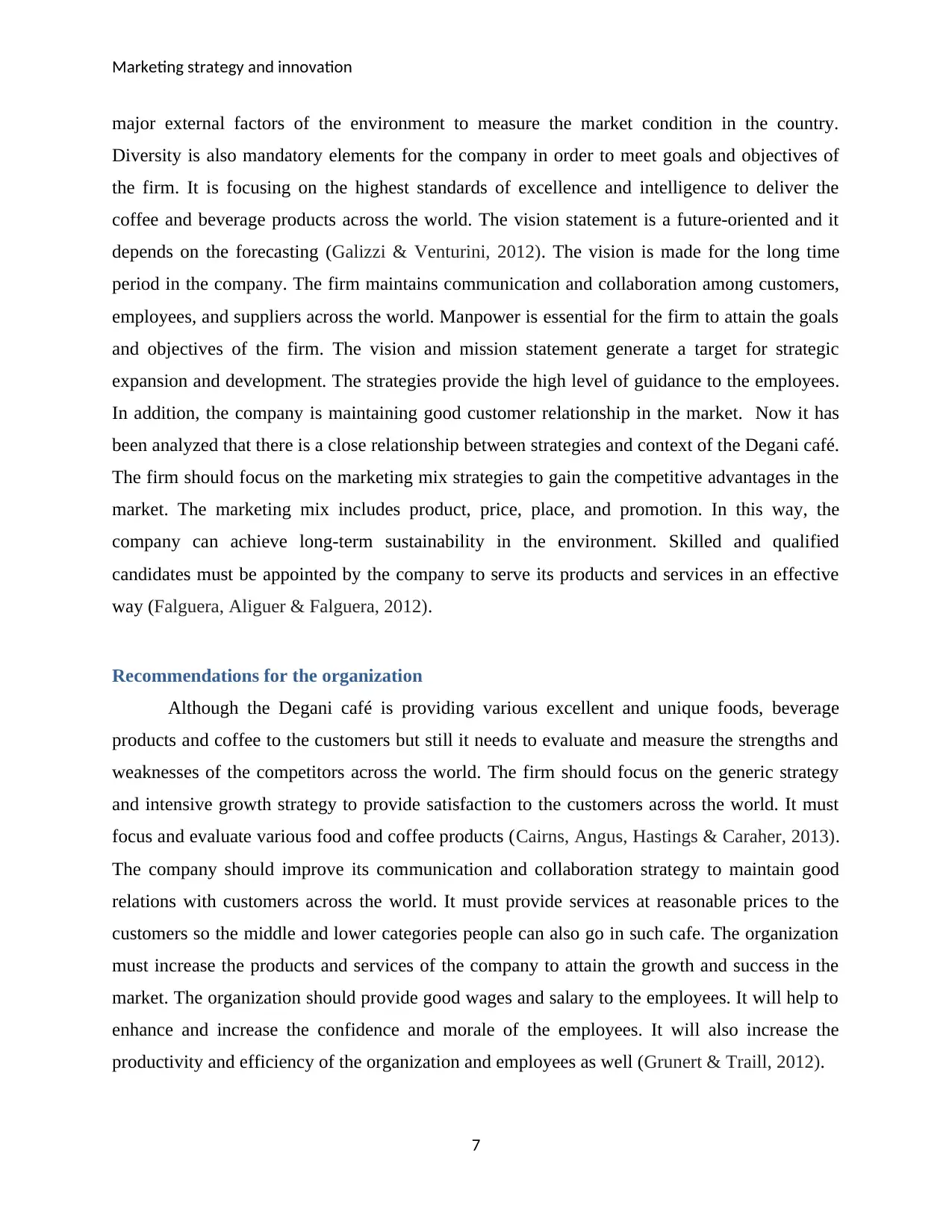
Marketing strategy and innovation
major external factors of the environment to measure the market condition in the country.
Diversity is also mandatory elements for the company in order to meet goals and objectives of
the firm. It is focusing on the highest standards of excellence and intelligence to deliver the
coffee and beverage products across the world. The vision statement is a future-oriented and it
depends on the forecasting (Galizzi & Venturini, 2012). The vision is made for the long time
period in the company. The firm maintains communication and collaboration among customers,
employees, and suppliers across the world. Manpower is essential for the firm to attain the goals
and objectives of the firm. The vision and mission statement generate a target for strategic
expansion and development. The strategies provide the high level of guidance to the employees.
In addition, the company is maintaining good customer relationship in the market. Now it has
been analyzed that there is a close relationship between strategies and context of the Degani café.
The firm should focus on the marketing mix strategies to gain the competitive advantages in the
market. The marketing mix includes product, price, place, and promotion. In this way, the
company can achieve long-term sustainability in the environment. Skilled and qualified
candidates must be appointed by the company to serve its products and services in an effective
way (Falguera, Aliguer & Falguera, 2012).
Recommendations for the organization
Although the Degani café is providing various excellent and unique foods, beverage
products and coffee to the customers but still it needs to evaluate and measure the strengths and
weaknesses of the competitors across the world. The firm should focus on the generic strategy
and intensive growth strategy to provide satisfaction to the customers across the world. It must
focus and evaluate various food and coffee products (Cairns, Angus, Hastings & Caraher, 2013).
The company should improve its communication and collaboration strategy to maintain good
relations with customers across the world. It must provide services at reasonable prices to the
customers so the middle and lower categories people can also go in such cafe. The organization
must increase the products and services of the company to attain the growth and success in the
market. The organization should provide good wages and salary to the employees. It will help to
enhance and increase the confidence and morale of the employees. It will also increase the
productivity and efficiency of the organization and employees as well (Grunert & Traill, 2012).
7
major external factors of the environment to measure the market condition in the country.
Diversity is also mandatory elements for the company in order to meet goals and objectives of
the firm. It is focusing on the highest standards of excellence and intelligence to deliver the
coffee and beverage products across the world. The vision statement is a future-oriented and it
depends on the forecasting (Galizzi & Venturini, 2012). The vision is made for the long time
period in the company. The firm maintains communication and collaboration among customers,
employees, and suppliers across the world. Manpower is essential for the firm to attain the goals
and objectives of the firm. The vision and mission statement generate a target for strategic
expansion and development. The strategies provide the high level of guidance to the employees.
In addition, the company is maintaining good customer relationship in the market. Now it has
been analyzed that there is a close relationship between strategies and context of the Degani café.
The firm should focus on the marketing mix strategies to gain the competitive advantages in the
market. The marketing mix includes product, price, place, and promotion. In this way, the
company can achieve long-term sustainability in the environment. Skilled and qualified
candidates must be appointed by the company to serve its products and services in an effective
way (Falguera, Aliguer & Falguera, 2012).
Recommendations for the organization
Although the Degani café is providing various excellent and unique foods, beverage
products and coffee to the customers but still it needs to evaluate and measure the strengths and
weaknesses of the competitors across the world. The firm should focus on the generic strategy
and intensive growth strategy to provide satisfaction to the customers across the world. It must
focus and evaluate various food and coffee products (Cairns, Angus, Hastings & Caraher, 2013).
The company should improve its communication and collaboration strategy to maintain good
relations with customers across the world. It must provide services at reasonable prices to the
customers so the middle and lower categories people can also go in such cafe. The organization
must increase the products and services of the company to attain the growth and success in the
market. The organization should provide good wages and salary to the employees. It will help to
enhance and increase the confidence and morale of the employees. It will also increase the
productivity and efficiency of the organization and employees as well (Grunert & Traill, 2012).
7
Paraphrase This Document
Need a fresh take? Get an instant paraphrase of this document with our AI Paraphraser
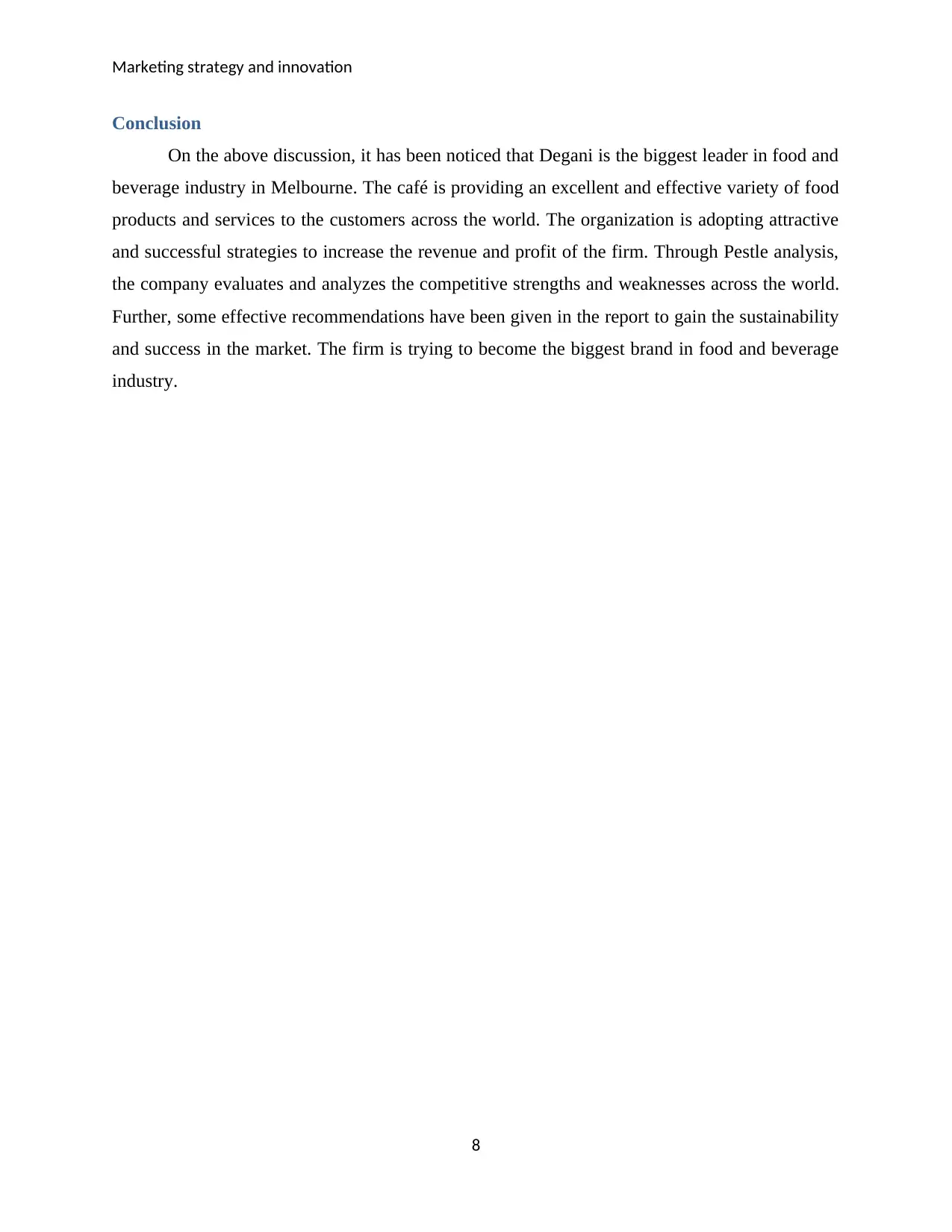
Marketing strategy and innovation
Conclusion
On the above discussion, it has been noticed that Degani is the biggest leader in food and
beverage industry in Melbourne. The café is providing an excellent and effective variety of food
products and services to the customers across the world. The organization is adopting attractive
and successful strategies to increase the revenue and profit of the firm. Through Pestle analysis,
the company evaluates and analyzes the competitive strengths and weaknesses across the world.
Further, some effective recommendations have been given in the report to gain the sustainability
and success in the market. The firm is trying to become the biggest brand in food and beverage
industry.
8
Conclusion
On the above discussion, it has been noticed that Degani is the biggest leader in food and
beverage industry in Melbourne. The café is providing an excellent and effective variety of food
products and services to the customers across the world. The organization is adopting attractive
and successful strategies to increase the revenue and profit of the firm. Through Pestle analysis,
the company evaluates and analyzes the competitive strengths and weaknesses across the world.
Further, some effective recommendations have been given in the report to gain the sustainability
and success in the market. The firm is trying to become the biggest brand in food and beverage
industry.
8
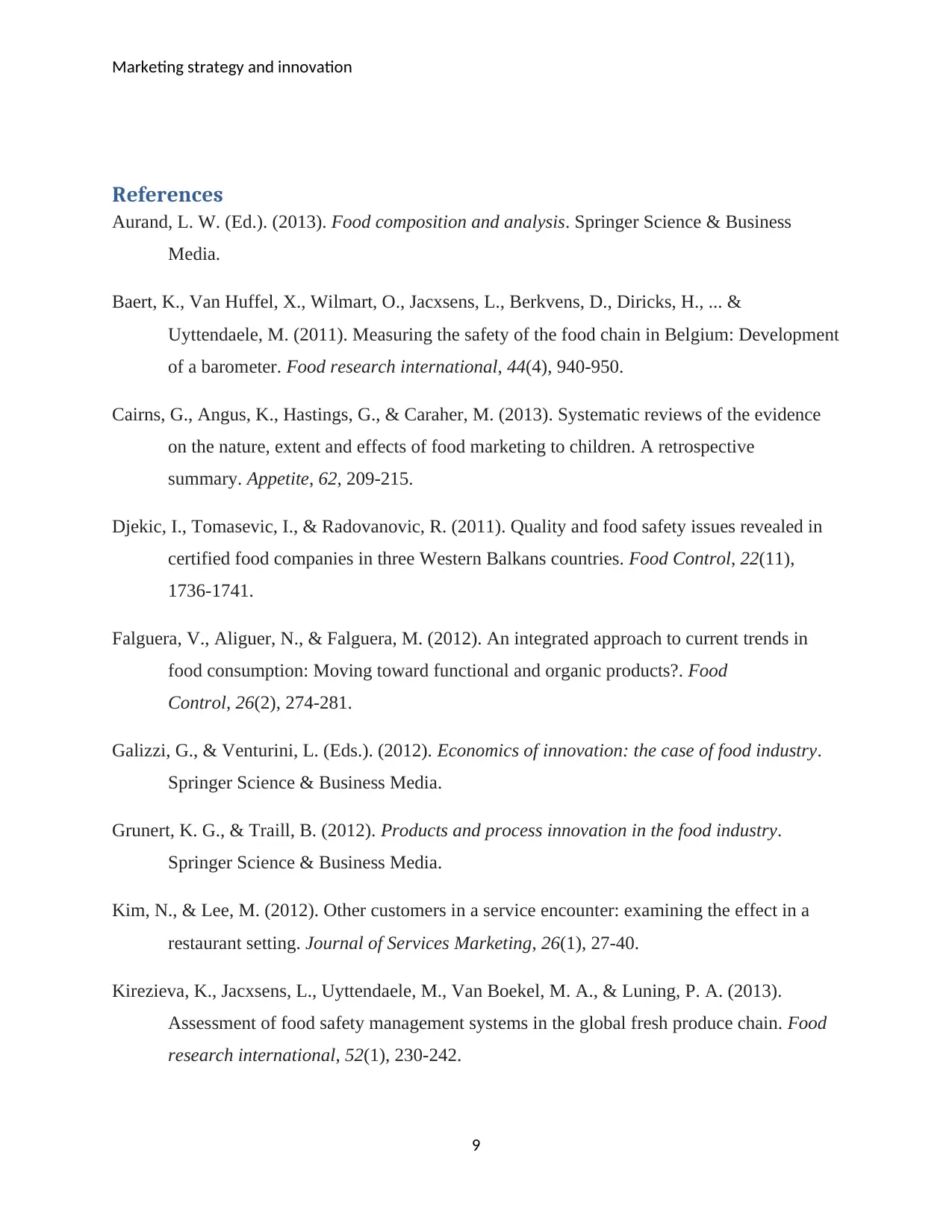
Marketing strategy and innovation
References
Aurand, L. W. (Ed.). (2013). Food composition and analysis. Springer Science & Business
Media.
Baert, K., Van Huffel, X., Wilmart, O., Jacxsens, L., Berkvens, D., Diricks, H., ... &
Uyttendaele, M. (2011). Measuring the safety of the food chain in Belgium: Development
of a barometer. Food research international, 44(4), 940-950.
Cairns, G., Angus, K., Hastings, G., & Caraher, M. (2013). Systematic reviews of the evidence
on the nature, extent and effects of food marketing to children. A retrospective
summary. Appetite, 62, 209-215.
Djekic, I., Tomasevic, I., & Radovanovic, R. (2011). Quality and food safety issues revealed in
certified food companies in three Western Balkans countries. Food Control, 22(11),
1736-1741.
Falguera, V., Aliguer, N., & Falguera, M. (2012). An integrated approach to current trends in
food consumption: Moving toward functional and organic products?. Food
Control, 26(2), 274-281.
Galizzi, G., & Venturini, L. (Eds.). (2012). Economics of innovation: the case of food industry.
Springer Science & Business Media.
Grunert, K. G., & Traill, B. (2012). Products and process innovation in the food industry.
Springer Science & Business Media.
Kim, N., & Lee, M. (2012). Other customers in a service encounter: examining the effect in a
restaurant setting. Journal of Services Marketing, 26(1), 27-40.
Kirezieva, K., Jacxsens, L., Uyttendaele, M., Van Boekel, M. A., & Luning, P. A. (2013).
Assessment of food safety management systems in the global fresh produce chain. Food
research international, 52(1), 230-242.
9
References
Aurand, L. W. (Ed.). (2013). Food composition and analysis. Springer Science & Business
Media.
Baert, K., Van Huffel, X., Wilmart, O., Jacxsens, L., Berkvens, D., Diricks, H., ... &
Uyttendaele, M. (2011). Measuring the safety of the food chain in Belgium: Development
of a barometer. Food research international, 44(4), 940-950.
Cairns, G., Angus, K., Hastings, G., & Caraher, M. (2013). Systematic reviews of the evidence
on the nature, extent and effects of food marketing to children. A retrospective
summary. Appetite, 62, 209-215.
Djekic, I., Tomasevic, I., & Radovanovic, R. (2011). Quality and food safety issues revealed in
certified food companies in three Western Balkans countries. Food Control, 22(11),
1736-1741.
Falguera, V., Aliguer, N., & Falguera, M. (2012). An integrated approach to current trends in
food consumption: Moving toward functional and organic products?. Food
Control, 26(2), 274-281.
Galizzi, G., & Venturini, L. (Eds.). (2012). Economics of innovation: the case of food industry.
Springer Science & Business Media.
Grunert, K. G., & Traill, B. (2012). Products and process innovation in the food industry.
Springer Science & Business Media.
Kim, N., & Lee, M. (2012). Other customers in a service encounter: examining the effect in a
restaurant setting. Journal of Services Marketing, 26(1), 27-40.
Kirezieva, K., Jacxsens, L., Uyttendaele, M., Van Boekel, M. A., & Luning, P. A. (2013).
Assessment of food safety management systems in the global fresh produce chain. Food
research international, 52(1), 230-242.
9
⊘ This is a preview!⊘
Do you want full access?
Subscribe today to unlock all pages.

Trusted by 1+ million students worldwide
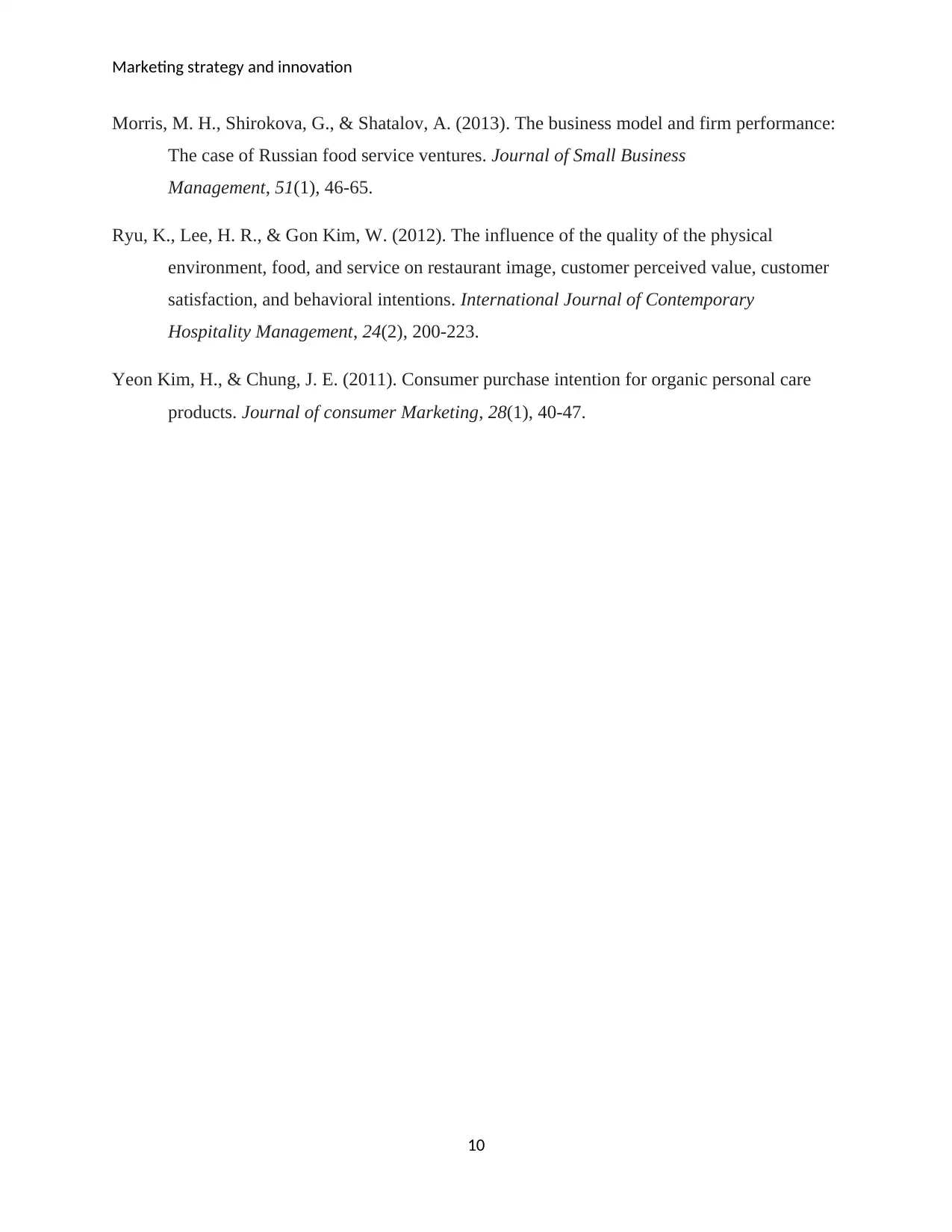
Marketing strategy and innovation
Morris, M. H., Shirokova, G., & Shatalov, A. (2013). The business model and firm performance:
The case of Russian food service ventures. Journal of Small Business
Management, 51(1), 46-65.
Ryu, K., Lee, H. R., & Gon Kim, W. (2012). The influence of the quality of the physical
environment, food, and service on restaurant image, customer perceived value, customer
satisfaction, and behavioral intentions. International Journal of Contemporary
Hospitality Management, 24(2), 200-223.
Yeon Kim, H., & Chung, J. E. (2011). Consumer purchase intention for organic personal care
products. Journal of consumer Marketing, 28(1), 40-47.
10
Morris, M. H., Shirokova, G., & Shatalov, A. (2013). The business model and firm performance:
The case of Russian food service ventures. Journal of Small Business
Management, 51(1), 46-65.
Ryu, K., Lee, H. R., & Gon Kim, W. (2012). The influence of the quality of the physical
environment, food, and service on restaurant image, customer perceived value, customer
satisfaction, and behavioral intentions. International Journal of Contemporary
Hospitality Management, 24(2), 200-223.
Yeon Kim, H., & Chung, J. E. (2011). Consumer purchase intention for organic personal care
products. Journal of consumer Marketing, 28(1), 40-47.
10
1 out of 10
Related Documents
Your All-in-One AI-Powered Toolkit for Academic Success.
+13062052269
info@desklib.com
Available 24*7 on WhatsApp / Email
![[object Object]](/_next/static/media/star-bottom.7253800d.svg)
Unlock your academic potential
Copyright © 2020–2025 A2Z Services. All Rights Reserved. Developed and managed by ZUCOL.


